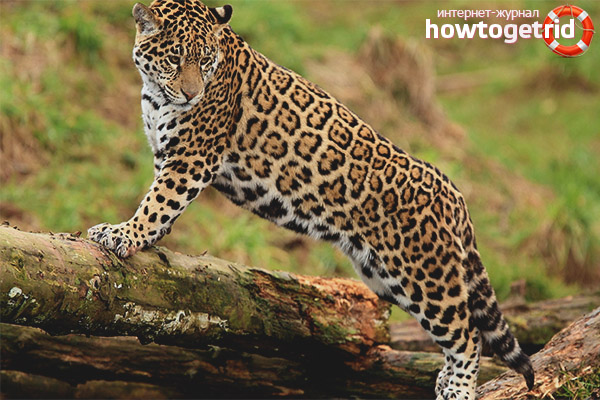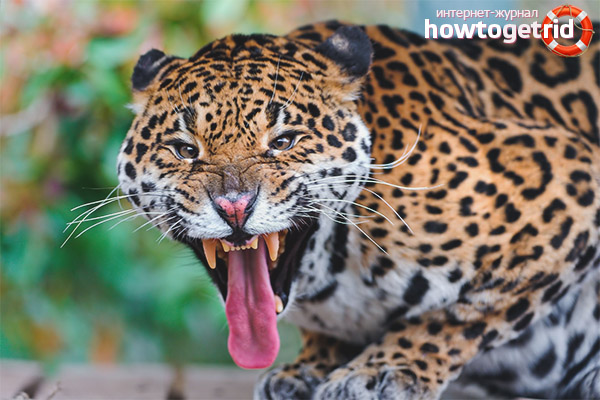The content of the article
Beautiful wild cats have always been the subject of discussion, so they do not need additional advertising. In today's article we will explore the most important characteristics affecting the jaguars. They are ranked among the largest predatory animals that can be characterized by bloodthirstiness and agility. A distinctive characteristic of these individuals is the manner of obtaining food, but there are other equally important aspects. Let's not get ahead of ourselves, consider everything in turn.
Description
- Otherwise, individuals of this family are called panther cats. They are wild, spotty, large. This is the most evil predator, which can be found in America. Especially powerful individuals reach about 80 cm at the withers with a graceful body length of 1.8 meters. However, jaguars are often not found with such a long body, the average is 1.3 meters.
- The tail part is shortened (up to 0.5 m.) Or long (up to 0.9 m.). On the mass of the body wild cats reach 70-135 kg. These animals have a pronounced sexual dimorphism. Females are inferior in weight to males, the same applies to overall characteristics. Interestingly, the maximum weight was recorded, which equals 158 kg.
- If a wild mammal lives in an open area, then it will be much larger than its counterparts. If the cat lives in the thickets, it loses some of its dimensions. Experts attribute this criterion to the fact that in the steppe open zones there are more cattle, respectively, the ration is better.
- Now we analyze in more detail the exterior of a mammal. With all her appearance, the cat shows strength and grace at the same time. The jaws have a square format, they are strong, with powerful teeth. The head is large compared to the rest of the body. The body is knocked down, thereby distinguishing these individuals from leopards. The head is similar to the format of a tiger's skull, and the body itself is reminiscent of other wild cats. Ears are rounded in size, small.
- The extremities are not as elongated as those of similar-looking cats.This criterion makes jaguars squat and not so high. Even with short legs, these individuals run very fast. They wield their body masterfully, driving and killing prey. The coat is short, condensed, soft. By tone, individuals can be reddish, yellowish, sandy. Black spots are scattered across the body.
- The shape of the markings can be completely different, starting with rings, ending elongated and straight. In the abdominal section there is a bright pigment, as well as on the neck and chest. The inner parts of the limbs are also highlighted. On the paws and head there are black blotches. There are yellow markings on the ears.
- These individuals roar strangely, very low, guttural. When night falls, they terrify the whole district. Jaguars roar than they look like lions. When wild cats make everyday sounds, they are comparable to coughing or roaring saws. When marriage games prevails it is the rumbling and purring.
- According to genetics, these individuals can be purely black, similar to panthers. But this is extremely rare. Often, babies born with this pigmentation die quickly.However, with proper care, for example, in a zoo or other specialized places, strong and powerful individuals can turn out.
Lifestyle
- It should start with the duration of the animals of this breed group. If they are kept in captivity, the cats will reach to 25 years. Those individuals that live in the wild, live about 12 years. As you can understand, the lifespan is so reduced due to the instability of the diet and attacks of opponents. Some cats die from the disease.
- These members of the family are characterized by a feature that manifests itself in the protection of its territory. Representatives of the male half regularly make rounds to keep everything under control. A minimum of 25 square meters is allocated for one animal. km Males need more space than females. They divide plots into triangles. Every three days they change the point of stay in the triangle, moving from one part of their possessions to another.
- Every 3 months, the animal begins to bypass its land around the perimeter and borders in particular. They do not allow pumas, ocelots and other cats to go beyond the selected borders.However, if another member of this species sets in, for example, a jaguar may allow. Mammals prefer to stay awake at dusk. They are chosen to hunt before the sunrise or after sunset.
- The hunt itself is worthy of discussion. The animal hides in the bushes or high vegetation. Can sit in the trees, hide near watering. The attack is carried out from the side or back of the victim, when she suspects nothing. First, the cat grabs the neck, then tries to bite the skull or strangle prey. The rest of the cats do not have the features of pulling the skull.
- When a cat chooses cattle for food, it tries to immediately fill it with cattle. This will cause injury to the skull, as a result, the cattle will be weakened and defeated. Some cats do not even use their teeth, as a broken neck leads to the death of the victim.
- Jaguars do not chase their prey or do it extremely rarely. Excellent hearing victims can escape as soon as they hear the danger approaching. The cat does not rush for her. The most important feature is that these cats swim perfectly, so they will easily catch prey in the aquatic environment.
Habitat
- Jaguars live on the northern border, which stretches from the southwestern US states along the Mexican steppes. The distribution area of animals is really amazing. They settle down to the northern outskirts of Paraguay and Argentina. In addition, the considered animals are often found even in Venezuela.
- It is worth noting that the largest representatives of this species mainly live in Brazil in Mato Grosso. Huge populations of such wild cats are mainly concentrated in the vastness of the Amazon. The considered individuals choose habitats based on several criteria.
- In such an area must necessarily be near the reservoir. Dense vegetation is an integral part. It is in it that the jaguar is masked and hunted. An important fact is that in such open spaces there must be a sufficient amount of production.
- All these resources are most often found in tropical forests with high humidity. Just nature took care of this. It is in this area that there are reed beds, swamps and river valleys. It is almost impossible to meet such feline representatives in arid areas.
- However, in mountainous terrain, wild cats are far from a wonder. Even here there are their borders. Jaguars do not climb above 2.5 km. above sea level. In the rest of the considered individuals do not attract mountain forests. Only once did an individual who was in Costa Rica at an altitude of about 4 km.
Diet
- The wild cats discussed are true predators that feed only on flesh. Such animals hunt for different prey. Studies have shown that 85 different species of animals fell into the jaguar's mouth. Presented predators can easily cope with an animal whose body weight can be about 300 kg.
- The greatest weakness of wild cats is to a large and fleshy ungulates. Jaguars often hunt livestock. In addition, the animals in question often attack monkeys, porcupines, birds, reptiles, foxes and rodents. When jaguars live near water bodies, they are happy to hunt fish.
- For such wild cats, a tortoise is considered a real delicacy. Such a predator has enough jaw power to crack the durable shell of the animal.In particular, animals love to feast on turtle eggs. They have no problem finding a clutch in the sand. However, the cats in question almost never touch the carrion.
- It is noteworthy that the animal of noble blood, after it has caught the prey, begins to eat it from the head. Finally, the jaguar leaves juicy ham. If such a predator was able to fill up a large animal, the cat will eat them for a few days. Jaguar will not leave this place until it satisfies all its needs.
The enemies
- As in most cases, for the most formidable predator the greatest danger is man. The problem is that people are constantly exterminating wild cats just for fun and valuable fur.
- In the wild, the jaguar is almost in no danger. They have no competitors, and no one hunts animals. Specifically in their habitat, the individuals in question are located at the top of the food chain.
- An interesting fact is that sometimes jaguars conflict with pumas over territory. However, represented animals almost always win. Sometimes jaguars have serious injuries.
- Predatory cats are so strong and fearless that they often collide with a dangerous opponent. Jaguars attack Caimans, even though they are in their native element. As a result, the predator pulls monsters onto the land, the length of which can be up to 2 m.
Breeding
- The individuals in question do not adhere to any particular time to begin the mating season. The female often reaches puberty at the age of 3 years. She then marks the trees with urine, telling the males that she is ready to mate. Also, the female emits characteristic sounds, the males respond the same.
- Jaguars tend to lead a solitary lifestyle. Only for procreation, they gather in small groups. Often, hunters for such wild cats take advantage of the situation. People have learned to lure males with a special sound, imitating a female.
- It is noteworthy that the males do not conduct fights with each other, the female chooses the chosen one independently and temporarily moves to its territory. After mating, the female independently deals with the arrangement of the lair and the rearing of the young. Pregnancy lasts about 3 months. In litter can be up to 4 kittens.
Unfortunately, jaguars are on the verge of extinction and are listed in the Red Book. Currently, hunting for wild cats is prohibited, animals are protected. However, poachers continue to engage in catching the considered individuals. Cats are valued for their unique skin.
Video: Jaguar (Panthera onca)














To send